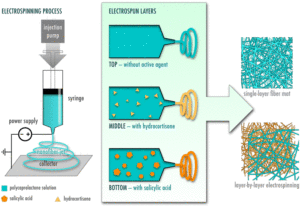A new nanofiber patch may provide “easier and more effective” psoriasis treatment, according to research out of the University of Copenhagen.
“We have developed a dry patch, which contains active ingredients for treatment of psoriasis, and which reduces the frequency of use to once a day. It has the potential to make treatment more comfortable for psoriasis patients,” says study author Associate Professor Andrea Heinz from the Department of Pharmacy, in a news release.
The patch is designed to contain two active ingredients at once and release them onto the skin at different rates.

Fig. 1: A schematic illustration demonstrating the electrospinning process for single-layer and layer-by-layer fiber mats, with and without active ingredients. The part on the left illustrates the electrospinning process, where a polymer solution is injected into an electric field through a syringe using a pump, leading to the deposition of polymer fibers on the collector. The center of the figure depicts the layered structure of electrospun materials, which can combine drug-free and drug-loaded layers. An electrospun dressing is produced, shown on the right, that can consist of either a single layer (blue) or multiple layers (orange, yellow, blue)
A. Gürtler, J. P. Sirois, J. C. Lang, K. Melican, T. Rades and A. Heinz, RSC Pharm., 2024, 1, 570 DOI: 10.1039/D4PM00147H
“It is really clever, because treatment of psoriasis often requires more than one product. The two ingredients are released in a controlled manner and at different rates, as they serve different functions: Salicylic acid is released immediately to remove the dead cells that have accumulated on the skin, while hydrocortisone decreases inflammation of the skin – a process that takes more time,” says study author Anna-Lena Gürtler. “We have tested the prototype on pig skin and human skin cells and compared the results to the creams and ointments available at pharmacies, and our studies show that the patch is just as effective as standard treatments.”
The researchers used electrospinning to produce the patch, a method where high voltage is applied to a polymer solution to produce synthetic nanofibers. The fibers are then used to make a fibre mat that may be attached to the skin like a plaster.
The researchers are still working on the patch. More research, product development and clinical trials are needed before the method is ready for use.
“A patch containing active ingredients may be an alternative to creams and ointments in the treatment of other inflammatory skin diseases, for instance atopic eczema. It may also be useful in connection with wound healing,” Heinz says.
The studies appear in Biomaterials Advances.

